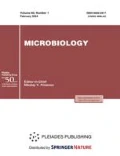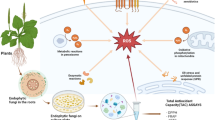Abstract
Phytogenous Phenolic and benzene compounds have been described as being responsible for many biological activities including antifungal effects. The effect of caffeine and cinnamic and caffeic acids on a model fungus, Aspergillus nidulans, was investigated at its initial stage of germination. Conidia did not germinate in the presence of cinnamic acid (1 mM). Caffeine and caffeic acid exerted a negative effect on germination, on the nuclear duplication cycle and on first septum formation. The effects of caffeine were dose-dependent; effects of caffeic acid (1 mM) were more intense than those of caffeine (10 mM).
Similar content being viewed by others
References
Slavin, J.L., Jacobs, D., Marquart, L., and Wiemer, K., The Role of Whole Grains in Disease Prevention, J. Am. Diet Assoc., 2001, vol. 101, no. 7, pp. 780–785.
Garcia-Conesa, M.T., Plumb, G.W., Waldron, K.W., Ralph, J., and Williamson, G., Ferulic Acid Dehydrodimers from Wheat Bran: Isolation, Purification and Antioxidant Properties of 8-O-4-diferulic Acid, Redox Rep., 1997, vol. 3, pp. 319–323.
Andreasen, M.F., Christensen, L.P., Meyer, A.S., and Hansen, A., Content of Phenolic Acids and Ferulic Acid Dehydrodimers in 17 Rye (Secale cereale L.) Varieties, J. Agric. Food Chem., 2000, vol. 48, no. 7, pp. 2837–2842.
Rice-Evans, C.A., Miller, N.J., and Paganga, G., Structure-Antioxidant Activity Relationships of Flavonoids and Phenolic Acids, Free Radic. Biol. Med., 1996, vol. 20, no. 7, pp. 933–956.
Neves, F.M., Kawano, C.Y., and Said, S., Effect of Benzene Compounds from Plants on the Growth and Hyphal Morphology in Neurospora crassa, Braz. J. Microbiol., 2005, vol. 36, no. 2, pp. 189–194.
Said, S., Neves, F.M., and Griffiths, A.J.F., Cinnamic Acid Inhibits The Growth of the Fungus Neurospora crassa, but is Eliminated as Acetophenone, Int. Biodeterior. Biodegrad., 2004, vol. 54, pp. 1–6.
Raman, P.N. and Rao, M.N., Antimicrobial Activity of Cinnamic Acid Derivatives, Ind. J. Exp. Biol., 1987, vol. 25, pp. 42–47.
Liu, L., Hudgins, W.R., Shack, S., Yin, M.Q., and Samid, D., Cinnamic Acid: a Natural Product with Potential Use in Cancer Intervention, Int. J. Cancer, 1995, vol. 62, no. 3, pp. 345–350.
Kanaani, J. and Ginsburg, H., Effects of Cinnamic Acid Derivatives on in vitro Growth of Plasmodium falciparum and on the Permeability of the Membrane of Malaria-infected Erythrocytes, Antimicrob. Agents Chemother., 1992, vol. 36, no. 5, pp. 1102–1108.
D’souza, C.A. and Heitman, J., Conserved cAMP Signaling Cascades Regulate Fungal Development and Virulence, FEMS Microbiol. Rev., 2001, vol. 25, no. 3, pp. 349–364.
Silva, R.N., da Silva, S.P., Brandão, R.L., and Ulhoa, C.J., Regulation of N-acetyl-beta-D-glucosaminidase Produced by Trichoderma harzianum: Evidence that cAMP Controls Its Expression, Res. Microbiol., 2004, vol. 155, no. 8, 667–671.
Mazzafera, P., Catabolism of Caffeine in Plant and Microorganisms, Front. Biosci., 2004, vol. 9, pp. 1348–1359.
Vanzela, A.P.F.C. and Said, S., Evidence for Carbon Source Regulated Protein Kinase A and Protein Kinase C Signaling in the Duplication Cycle, Polarization and Septum Formation in Aspergillus nidulans, Microbiol. Res., 2002, vol. 157, no. 3, pp. 239–247.
Cove, D.J., The Induction and Repression of Nitrate Reductase in the Fungus Aspergillus nidulans, Biochim. Biophys. Acta, 1966, vol. 113, no. 1, pp. 51–56.
Ohi, M., Kitamura, T., and Hata, S., Stimulation by Caffeic Acid, Coumaric Acid, and Corilagin of Germination of Resting Spores of Clubroot Pathogen Plasmodiophora brassicae, Biosci. Biotechnol. Biochem., 2003, vol. 67, no. 1, pp. 170–173.
Beach, D., Rodgers, L., and Gould, J., RAN1 + Controls the Transition from Mitotic Division to Meiosis in Fission in Yeast, Curr. Genet., 1985, vol. 10, pp. 297–311.
Shimizu, K. and Keller, N., Genetic Involvement of cAMP-dependent Protein Kinase in a G Protein Signaling Pathway Regulating Morphological and Chemical Transitions in Aspergillus nidulans, Genetics, 2001, vol. 157, pp. 591–600.
Ivey, F.D., Yang, Q., and Borkovich, K.A., Positive Regulation of Adenylyl Cyclase Activity by a Gαi Homolog in Neurospora crassa, Fungal Gen. Biol., 1999, vol. 26, pp. 48–61.
Author information
Authors and Affiliations
Corresponding author
Rights and permissions
About this article
Cite this article
Yuvamoto, P.D., Said, S. Germination, duplication cycle and septum formation are altered by caffeine, caffeic acid and cinnamic acid in Aspergillus nidulans . Microbiology 76, 735–738 (2007). https://doi.org/10.1134/S0026261707060136
Received:
Issue Date:
DOI: https://doi.org/10.1134/S0026261707060136




